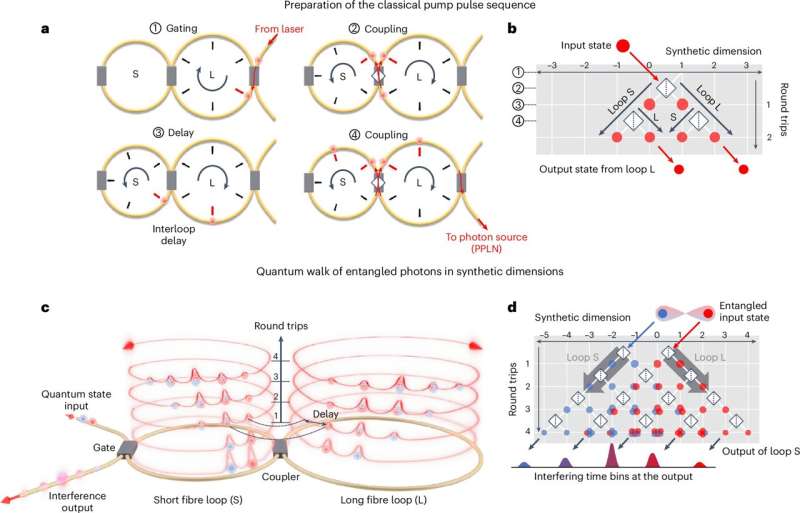
October 17, 2024 by INRS
Collected at: https://phys.org/news/2024-10-quantum-breakthrough-synthetic-dimensions-efficiently.html
A new study opens the door to cutting-edge solutions that could contribute to the realization of a system capable of processing quantum information in a simple yet powerful way.
Their work, just published in the journal Nature Photonics, presents a method for manipulating the photonic states of light in a never-before-seen way, offering greater control over the evolution of photon propagation. This control makes it possible to improve the detection and number of photon coincidences, as well as the efficiency of the system.
The study was co-directed by Professor Roberto Morandotti of Institut national de la recherche scientifique (INRS) in collaboration with teams from Germany, Italy, and Japan.
Unsuspected properties
Central to the research team’s experiments is the concept of quantum walks. “The development of the field of quantum computing, which began some twenty years ago, has benefited greatly from the notion of quantum walks, which are known to increase the speed and complexity of computer algorithms,” explains Professor Morandotti, whose laboratory is based at the INRS Énergie Matériaux Télécommunications Research Centre.
Recently, the scientific community developed another concept: synthetic photonic networks. “This work enables us to use the concept of synthetic photonics dimensions to explore many quantum phenomena at the fundamental level, and to apply them to quantum technologies,” explains Stefania Sciara, a post-doc on Morandotti’s team and co-author of the study.
The potential of this type of lattice was already known, for example to simulate effects such as parity-time symmetry, superfluidity of light and topological structures, but using conventional technology.
“But despite their potential,” she adds, “a synthetic photonic lattice capable of handling quantum states had never been demonstrated.”
This is precisely what Morandotti and his team have done. They have discovered a temporal synthetic photonic lattice capable of generating and manipulating quantum states of light (photons), using the concept of quantum walks in simple fiber systems.
“Our team has discovered how to use synthetic photonic lattices to process quantum information, based on the quantum walks of high-dimensional photons entangled in their temporal states,” reports Morandotti. “The system doesn’t require a lot of resources, as it consists of fiber devices, which are compatible with standard telecom infrastructures.”
An innovative technique with wide-ranging applications
This breakthrough opens the door to the use of synthetic photonic lattices simplified by the use of quantum walks for quantum information processing.
“Our approach is unprecedented for two reasons,” says Morandotti. “It allows better control of the evolution of quantum walks in the time domain, and it makes possible the simultaneous manipulation of classical light and entangled photons. This discovery paves the way for a variety of advanced quantum computing and information protocols on telecom-ready architectures compatible with microprocessor chips.”
Several fields of fundamental physics linked to quantum information processing can benefit from the researchers’ results, including quantum computing, quantum metrology, and secure quantum communications.
“Our system is entirely based on fiber-optic devices used in the telecommunications field and can be combined with current and future telecommunications infrastructures,” says Sciara. “This discovery is proof that it is possible to realize high-performance quantum systems using devices, techniques, and infrastructures that are within reach. It also demonstrates that it is possible to use quantum networks to transmit personal data securely.”
The article study was co-authored by Monika Monika, Farzam Nosrati, Agnes George, Stefania Sciara, Riza Fazili, André Luiz Marques Muniz, Arstan Bisianov, Rosario Lo Franco, William J. Munro, Mario Chemnitz, Ulf Peschel, and Roberto Morandotti.
More information: Monika Monika et al, Quantum state processing through controllable synthetic temporal photonic lattices, Nature Photonics (2024). DOI: 10.1038/s41566-024-01546-4
Journal information: Nature Photonics

Leave a Reply